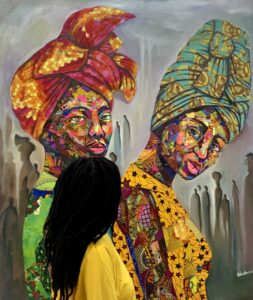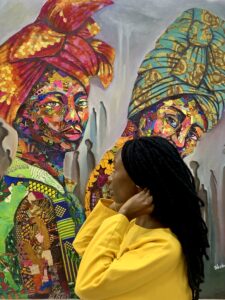Addressing Discomfort
A Strange Note in December*
There are days when we get stuck. Days when clouds wrap our heads. Grey clouds. Heavy clouds of busyness and confusion and the feeling of incompetence that balloons into a state of discomfort — with ourselves and our art. Days when we plug our body into activities, into routines, into the necessities of life but our inner self hammers us distressingly, calling us to see that its cup is too full to function right. And when we don’t listen — which is quite often — to its call, we find ourselves being heavily distracted, unfocused and, consequently, unable to produce the best results in our ventures.
So, what do we do on such days? How do we shovel our minds from the maze of restlessness or, perhaps best, clear the weed that locks it within?
The self is a spectrum of colours. Black today, blue tomorrow, yellow the next, etc. We stand at the centre of the colour wheel, forming analogous, triadic, tetradic groups of colours to match each hue and create balance in the chaos that is life. Until, of course, we lose control of our ground — overwhelmed by the many tints, tones and shades that reside in each hue.
It is here, in this state of overwhelm, that our tired self absorbs all colours in equal parts and reflects none. It is here that we turn black. But it is here, too, that we’re called to stand at the centre of the pallet — not in an attempt to merge colours. Rather, to the centre that marries us to the earth and helps us see the (not so) hidden truth about our state of being. Silence.
Silence opens us to a world within ourselves that we never thought to explore. It shows us the source of our discomfort and our tailored path into clarity. And so when Abramović writes that ‘an artist has to create a space for silence to enter [their] work,’ it speaks to the need to make room in our busy lives for moments of reflection; to make space for silence in our centre — from which we stand and merge hues into fine collections. The self is an artist within the canvas of life. And, as Abramović reflectively noted, an artist has to understand silence.
More than this, more than understanding silence and mixing hues to create balance in our life, an artist understands that there is home in art; that art is another remedy for addressing discomfort.

On the second day of December 2021, my sister opened me to the connection between music and non-human elements. She lit an incense stick, scrolled through her phone’s screen, sat the stick by a raffia basket, and moved her phone closer to its flames, Ludovico Einaudi’s Night floating from its speakers.
I watched as the smoke slithered through the air, walking past our noses and blanketing the room with its sweet amber smell. I watched as it curled to the sound of Night, vibrated to its rhythm, whorled its whiteness around my eyes, and showed me that sound is a form of language in itself; that after silence — as Aldous Huxley beautifully expressed — that which comes nearest to expressing the inexpressible is music.
Music is the only art form that touches us equally, converging our distinct experiences into a large ball of sameness. Music awakens us, puts us to sleep, sets our restlessness at ease, stores our experiences in buckets of nostalgia. Its rhythm soothes our injuries and untightens the pressure within. I love Friedrich Nietzsche’s reflection that: God has given us music so that above all it can lead us upwards. Music unites all qualities: it can exalt us, divert us, cheer us up, or break the hardest of hearts with the softest of its melancholy tones. But its principal task is to lead our thoughts to higher things, to elevate, even to make us tremble.
Art, overall, helps us see and be seen. And what is more enriching than seeing? Knowing truths and ourselves and other human beings. What is more powerful than being seen? Both by ourselves, another, and the world. Sometimes, our mind only needs the notes of music, the world of fiction, the strokes of an art piece, the sound of nature, to address discomfort and come into itself again.
And when Art fails (if at all), when the corners of silence feel too heavy for our tired minds, when both art and silence offer us gift baskets of consolation but the self still needs another form of release (one where the tongues spit the discomfort within), then opening up to another human being is the best we can do for the self.

A true friend, I have found, is one that touches our lives with the core elements of knowing another person, almost (and if not) intimately; one with whom we share the energy called love, which, in its purest form, emerges from the patience of attentiveness and understanding. True friendship is one in which we can see ourselves, share joyous memes, laugh about our silliness and bad choices, find comfort in our loneliness, even carve a path from a crisis.
It is, of course, not untrue that friendship doesn’t always wear enough strength to lift us from distress. For some of us, friendship is a complicated thing — we might be plagued by an inability to make friends with ease, or we centre ourselves in (non)friendships to which we give and give and are not given because we either do not know how to ask or are perceived as having ourselves so well together that not asking turns into an unwritten (although false) rule.
Other times, friendship simply doesn’t have the right answers to help us see the deeper parts of ourselves and how we can move forward. It is for these reasons that we have to pull ourselves into therapy; into the arms of a stranger whose job is to guide us to betterness. Therapy, interestingly, is a form of friendship; a space in which we can be ourselves with another self.
I often find myself going back to John O’Donohue’s revelatory message that ‘the one you love, your Anam Cara, your soul friend, is the truest mirror to reflect your soul. The honesty and clarity of true friendship also bring out the real contour of your spirit.’
True friendship is one in which we can unashamedly bring our fragility to the surface and address the source of our discomfort.
1 Question for You
How have you addressed discomfort in the past?
What you should read next:
Today, 5 December 2021, marks a year since I began my journey with Strange Notes. These notes have helped me deconstruct ideas and contribute to the basket of discourses around what it means to exist in this world. Since December 2020, I’ve written countless incomplete notes, some unpublished notes, and 16 pieces of work that first found a home on Medium before undergoing some changes and landing here, in its own home. The next texts are an outline of every note published between December 2020 and December 2021. I hope these notes — which are of a timeless nature — add to the fullness of your life.
Essays
Motsi: Bouncing Back from Rejection
ለካቲት (Lekatit): Forks as Metaphors for Identity
EyoKwindla: The Beautiful Side of Hardship
Shinde: What is Nothing?
Part B
April: Should We Redefine Free Will?
May: The problem with solving problems and The Feeling of Being Alone
Transitory Note in May: Things are changing
Part C
June: Why is Everything so Uncertain?
July: Divorcing Addiction from Love
August: Why we seek Validation
September: What’s in it for me?
October: How to be the last
November: The stories we tell ourselves
December: Addressing Discomfort
Languages
Although I don’t (yet) wear the gift of multilingualism, I am thoroughly fascinated by languages. And it’s with this fascination that I chose to house a tree of famed and minority African languages in each piece of Strange Note. Here’s a highlight of the languages covered within the past year:
Motsi: The Shona word for the letter, one. Elaborated in this Note.
ለካቲት (Lekatit): The Tigrinya word for February. Elaborated in this Note.
EyoKwindla: The Xhosa word for the month, March. Elaborated in this Note.
Shinde: The Bemba word for the month of April. Elaborated in this Note.
Awril: The Wolof word for the month, April. Elaborated in this Note.
Oṣù Ẹ̀bìbì: The Yorùbá word for the month, May. Elaborated in this Note.
Mayyu: The Berber word for the month, May. Elaborated in this Note.
Semmus: The Tachelhit word for the number, 5. Elaborated in this Note.
ⴼ: The Tamazight letter for the alphabet, F. Elaborated in this Note.
Sebεa: The Kabyle word for the number seven. Elaborated in this Note.
Yah: The Tamajaq word for the alphabet, H. Elaborated in this Note.
Tẓza: The Berber word for the number, nine. Elaborated in this Note.
Guumà: The Bade word for the number, ten. Elaborated in this Note.
Nuwamba: The Hausa word for the month, November. Elaborated in this Note.
 @etashelinto
@etashelinto